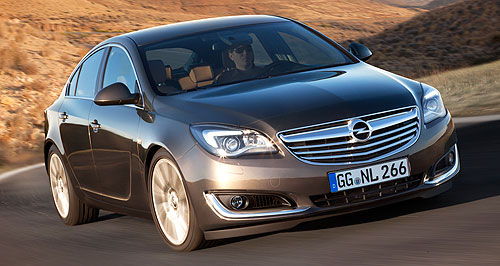Make / Model Search
News - HoldenInsignia firms as Holden Commodore replacementSwap meet: Holden is believed to be preparing to replace the locally made Commodore large car with a rebadged Opel Insignia. Next-gen Insignia internally branded a Holden, despite Opel origins29 Aug 2014 By BARRY PARK HOLDEN is slowly shaping up its showroom for a life without manufacturing, making plans to broaden its product portfolio ahead of the 2017 sign-off – including an Australian focussed Insignia mid-size car. The car-maker has said it will introduce a number of rebadged Opel models to Australia next year, including the Cascada four-seat convertible, but only performance-honed versions of the Holden Cruze-sized Astra hatch and Insignia mid-size car. However, documents seen by GoAuto suggest that Holden is also preparing to import a range of other Opel models including an all-new Corsa city hatchback unveiled wearing a Vauxhall badge earlier this month, more variants of the Holden Cruze-sized Astra hatchback and even the Opel Zafira seven-seat people-mover that was due to launch in Australia shortly before the brand spectacularly folded last year. The Insignia is also included in the documentation and is referred to as a Holden as opposed to an Opel, which could point to a wider range of variants than the high-performance VXR that will be offered from the first half of next year. Documents released to GoAuto under freedom of information legislation earlier this year show the car-maker had planned to build a front-wheel-drive replacement for the Commodore large car based on parent company General Motors’ Epsilon platform, which underpins the Insignia, shortly before the decision was made to quit manufacturing. Speculation has suggested Holden’s fully imported replacement for the Commodore – which is likely to wear the same badge – could cast as widely as either China or Europe, with the European sourcing becoming more likely in media reports today. A Holden spokesman declined to comment on the reports. Opel’s Insignia was updated significantly late last year, and expanded to add a Subaru Outback-rivalling SUV-styled wagon version for the first time – a fast-growing segment in the Australian market. The withdrawal from Australian manufacturing in 2017, which will end more than 60 years of local car production, is presenting Holden with an opportunity to completely revamp its showrooms, culling under-performing variants as it adds more models sourced primarily from South Korea, the United States and Europe. It gives Holden a means to revive the Viva badge – not seen in Australia since the car-maker dropped the Korean-sourced front-wheel-drive hatch, sedan and wagon range in 2009 – with plans to reintroduce the nameplate on an updated, right-hand-drive version of the Korean-made Barina Spark in the United Kingdom next year. While Holden remains coy about how its showroom will look post local Commodore and Cruze production, traditional rival Ford Australia has already laid plans for how its product mix will change once it signs off the Falcon and Territory in late 2016. Changes include the Ranger ute-based Everest seven-seat SUV, and a new version of the Ford Transit courier van that is already on sale in other international markets and the possible addition of the Ford Edge mid-size SUV as a Territory replacement. Of importance to both Ford and Holden, however, are the fleet sales it will lose as businesses, rental car companies and government drop the “buy Australian” mandate for their model mixes. Mazda, Australia’s best-performing full-line importer, has already flagged that “user choosers” – fleet buyers who allow drivers to nominate which vehicle they steer – will push the fleet market to behave more like that of private buyers, creating an opportunity for those brands that already appeal to those customers. The downside in any shift in buyer preference is crucial for Holden, with its Commodore large car a near-permanent fixture in the list of Australia’s top 10 best-sellers – presenting a big challenge for the Commodore’s potential replacement. Sales to fleet, government and rental buyers currently account for two out of every five cars bought in the passenger car and SUV segment. Government buyers – the ones with the strongest buy-Australian mandate – are the only member of that group to increase the number of passenger car sales over the first seven months of this year, up by 8.8 per cent compared with the same period last year, while private, business and rental buyers are all down between 2.9 to 5.7 per cent. Reflecting how much the market has changed, private buyers lead the SUV-buying trend to push numbers 14.6 per cent higher than the same period last year, with government and rental buyers increasing their interest in the segment by 7.2 and 3.3 per cent respectively. Business buyers, meanwhile, have turned off buying the high-riding wagons, with sales to the end of July falling off 10.6 per cent. One of Australia’s largest fleet companies, Maxxia, declined to say how much it expected the market’s dynamics to shift once the tap was turned off on buying Australian-made cars, only acknowledging that it did have the potential to affect the mix of models bought.  Read more15th of August 2014  Holden’s future product locked inLocal dealers informed of future model line-up, but Holden keeps quiet1st of May 2014  Holden to keep its proving ground, rebadge Opel carsGM hangs on to Holden’s proving ground as covers come off lion-badged Opel line-up |
Click to shareHolden articlesResearch Holden Motor industry news |











Facebook Twitter Instagram